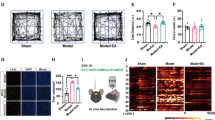Abstract
The action of electroacupuncture (EA) may be similar to analgesia by electrode stimulation or transcutaneous nerve stimulation. Since EA may directly stimulate nerve activity or indirectly enhance the release of opiate peptides and other neurotransmitter substances, we have used (Na++K+)-ATPase as a model to study the mechanism of action of EA. The membrane-bound (Na+K)-ATPase from purified synaptic plasma membranes inhibited slightly by high concentration of endorphin (30 μM), but not by met-enkephalin up to 6×10−4M. A single EA treatment for 30 min did not alter the (Na++K+)-ATPase activity in the cerebral cortex. However, when rats were treated with low (4 Hz) or high (200 Hz) frequency EA 30 min daily for 3 weeks, both (Na++K+)-ATPase and acetylcholinesterase were significantly elevated. The enhanced (Na++K+)-ATPase activity after high frequency EA was only partially blocked by i.p. injection of naloxone prior to EA during the last week of the EA treatment program. The results indicated that EA treatment may involve some other neurotransmitter pathways besides opiate peptides.
Similar content being viewed by others
References
Andersson, S. A., Ericson, T., Holmgren, E., andLinqvist, G. 1973. Electroacupuncture: effect on pain threshold measured with electrical stimulation of teeth. Brain Res. 63:393–396.
Ulett.G. A. 1981. Acupuncture treatment for pain relief. J. Am. Med. Assoc. 20, 768–769.
Sjolund, B. H., Terenius, L., andEriksson, M. B. E. 1977. Increased cerebrospinal fluid levels of endorphins after electroacupuncture. Acta Physiol. Scand. 100:383–384.
Amir, S., andAmit, Z. 1979. The pituitary gland mediates acute and chronic pain responsiveness in stressed and non-stressed rats. Life Sci. 24:439–448.
Pomerantz, B., andChiu, D. 1976. Naloxone blockade of acupuncture analgesia: endorphin implicated. Life Sci. 19:1757–1762.
Ha, H. C., Tan, E. C., Fukunaga, H., andAochi, O. 1981. Naloxone reversal of acupuncture analgesia in the monkey. Exp. Neurol. 73:298–303.
Mayer, D. J., Price, D. D., andRafii, A. 1977. Antagonism of acupuncture analgesia in man by the narcotic antagonist naloxone. Brain Res. 121:368–372.
Han, J. S., andTerenius, L. 1982. Neurochemical basis of acupuncture analgesia. Ann. Rev. Pharmacol. Toxicol. 22:193–220.
Guerrero-Munoz, F., Guerrero, M. L., andWay, E. L. 1979. Effect of morphine on calcium uptake by lysed synaptosomes. J. Pharmacol. Expt. Ther. 211:370–374.
Guerrero-Munoz, F., Guerrero, M. L., Way, E. L., andLi, C. H. 1980. Effect of β-endorphin on calcium uptake in the brain. Physchopharmacol. Bull. 16(2):57–58.
Williams, N., andClouet, D. H. 1982. The effect of acute opioid administration on the phosphorylation of rat striatal synaptic membrane proteins. J. Pharmacol. Expt. Ther. 220:278–286.
Sun, A. Y., andSun, G. Y. 1976. Functional roles of phospholipids of synaptosomal membrane, Pages 169–197,in G. Porcellati, L. Amaducci, andC. Galli (eds.), Function and Metabolism of Phospholipids in CNS and PNS. Plenum Press, New York.
Jain, M. L., Curtis, B. M., andBakutis, E. V. 1974. In vivo effect of LSD, morphine, ethanol, 9-tetrahydrocannabinol on mouse brain adenosine triphosphatase activity. Res. Comm. Chem. Pathol. Pharmacol. 7:229–232.
Desaiah, D., andHo, I. K. 1977. Effect of morphine on mouse brain ATPase activities. Biochem. Pharmacol. 26:89–92.
Vizi, E. S., Torok, T., Seregi, A., Serfozo, P., andAdam-Vizi, V. 1982. (Na+K)-activated ATPase and the release of acetylcholine and noradrenaline. J. Physiol. (Paris) 78:399–406.
Chang, C-G., andChiang, R. T. 1982. Acupuncture Manual, Pages 71–73, The points of the fourteen meridians and the extraordinary points. China Medical College Publishing Press, Taichung, Taiwan.
Wright, M., andMcGrath, C. J. 1981. Physiological and analgesic effects of acupuncture in the dog. J. Am. Vet. Med. Assoc. 178:502–507.
Sun, A. Y., andSamorajski, T. 1970. Effects of ethanol on the activity of adenosine triphosphatase and acetylcholinesterase in synaptosomes isolated from guinea pig brain. J. Neurochem. 17:1365–1372.
Lowry, O. H., Rosebrough, N. J., Farr, A. L., andRandall, R. L. 1951. Protein measurement with the Folin phenol reagent. J. Biol. Chem. 193:265–275.
Akil, H., andMayer, D. J. 1972. Antagonism of stimulation-produced analgesia by p-CPA, a serotonin synthesis inhibitor. Brain Res. 44:692–697.
Basbaum, A. I., andFields, H. L. 1978. Endogenous pain control and mechanisms: Review and hypothesis. Annals Neurol. 4:451–462.
Sjolund, B., andEriksson, M. 1979. The influence of naloxone on analgesic produced by peripheral conditioning stimulation. Brain Res. 173:295–301.
Meyerson, B. A. 1983. Electrostimulation procedures: Effects, presumed rationale and possible mechanisms. Adv. Pain Res. Ther. 5:495–534.
Jeffe, R. A., Laszewski, B. L., Carr, D. B., andPhillips, R. D. 1980. Chronic exposure to a 60 Hz electric field: effect on synaptic transmission and peripheral nerve function in the rat. Electromagnetics 1:131–147.
Battaini, F., andPeterkofsky, A. 1980. Histidylproline diketopiperazine, an endogenous brain peptide that inhibits (Na+K)-ATPase. Biochem. Biophys. Res. Commun. 94:240–247.
Akil, H. D., Mayer, D. J., andLiebeskind, J. C. 1976. Antagonism of stimulationproduced analgesia by naloxone, a narcotic antogonist. Science 191:961–962.
Chiueh, C. C., andMoore, K. E. 1974. In vivo release of endogenously synthesized catecholamines from the cat brain evoked by electrical stimulation and by d-amphetamine. J. Neurochem. 23:159–168.
Cheng, R. S. S., andPomerantz, B. 1979. Electroacupuncture analgesia could be mediated by at least two pain-relieving mechanisms: endorphin and non-endorphin systems. Life Sci. 25:1957–1962.
Author information
Authors and Affiliations
Rights and permissions
About this article
Cite this article
Lee, D.Z., Sun, A.Y. Effect of electroacupuncture on synaptosomal (Na++K+)-ATPase. Neurochem Res 9, 669–678 (1984). https://doi.org/10.1007/BF00964513
Accepted:
Issue Date:
DOI: https://doi.org/10.1007/BF00964513




